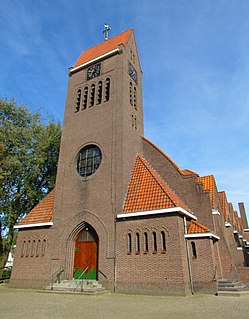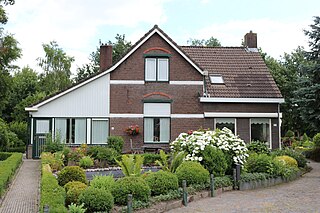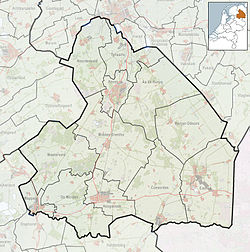
Vlagtwedde is a village in the very southeast of Groningen province in the northeastern Netherlands. It lies on the Dutch border with the German state of Lower Saxony to the east.

Emmen is a municipality and town of the province of Drenthe in the northeastern Netherlands.

Barger-Compascuum is a village in the Dutch municipality of Emmen. It is in a peat-producing region of Drenthe. Veenpark, an open-air museum, is dedicated to the peat history of the region.

Veenoord is a village in the Netherlands and it is part of the Emmen municipality in Drenthe. It forms a single urban area with Nieuw-Amsterdam. Vincent van Gogh stayed in the Scholte Inn during his Drenthe period.

Weiteveen is a village in the Netherlands and is part of the Emmen municipality in Drenthe.

Amsterdamscheveld is a hamlet in the Netherlands and is part of the Emmen municipality in Drenthe.
Barger-Erfscheidenveen is a hamlet in the Netherlands and it is part of the Emmen municipality in Drenthe.

Barger-Oosterveen is a hamlet in the Netherlands and is part of the Emmen municipality in Drenthe.
Ermerveen is a hamlet in the Netherlands and it is part of the Emmen municipality in Drenthe.

Klazienaveen-Noord is a hamlet in the Netherlands and it is part of the Emmen municipality in Drenthe.

Middendorp is a hamlet in the Netherlands and is part of the Emmen municipality in Drenthe.

Oosterse Bos is a hamlet in the Netherlands and is part of the Emmen municipality in Drenthe.

Oranjedorp is a village in the Netherlands and it is part of the Emmen municipality in Drenthe.

Weerdinge is a neighbourhood and former village of Emmen in the Dutch province of Drenthe.

Westenesch is a hamlet in the Netherlands and it is part of the Emmen municipality in Drenthe. There are two dolmen in Westenesch.

Westerse Bos is a hamlet in the Netherlands and is part of the Emmen municipality in Drenthe.

Een-West is a hamlet in the Netherlands. It is part of the Noordenveld municipality in Drenthe.

Norgervaart is a hamlet in the Netherlands and is part of the Noordenveld municipality in Drenthe. It is located along the eponymous canal. The canal between Norg and Huis ter Heide was completed in 1816.
Compascuus is Latin for commonly grazed, and hence often used in the forms ager compascuus and compascuum. In the early republic, there were three kinds of land: private, public and common pasture. The Lex Agraria, that formalized the existing situation after the land reforms, set limits on how much cattle an individual could graze on ager compascuus without having to pay dues.

Willem Albert Scholten was a Dutch industrialist and landowner. He established the potato starch factory Eureka in Foxhol which laid the foundation of an industrial empire. Scholten would own 24 factories in Europe. He owned large plots of land in Drenthe for peat extraction, and was one of the founders of what would become the Holland America Line. In Groningen, Scholten built the Scholtenhuis, a large residential house on the Grote Markt, the main square, opposite the City Hall.



















